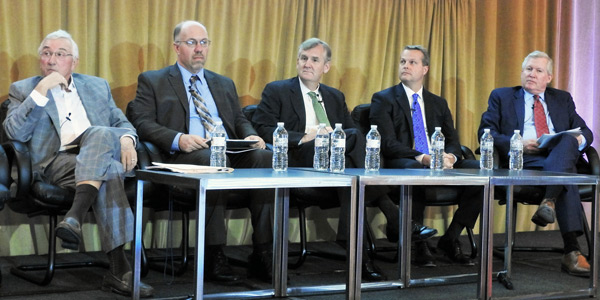By Rory D. Sweeney
CHICAGO — The times, they are a-changing — again. How will companies respond?
Executives from a utility, an independent power producer, a large industrial customer, a municipal power company and a power retailer met in a panel discussion at PJM’s Annual Meeting last week to answer that question. Unsurprisingly, their answers differed based on their role in the markets.
“We are in an energy transition. … Every company in this room is going to have to figure out how to participate in an energy transition, and if we don’t, we’re going to get run over,” said Larry Stalica, president of Linde Energy Services. “I believe there’s enough smart people in this room to figure out how to get from Point A to Point B.”
Linde, whose industrial and medical gas production facilities are big power users, became its own load-serving entity in March 2003. “We realized that these wholesale markets were going to be the key to controlling our costs and making our business successful,” he said. “So we wanted our voice heard.”
His call for leadership was echoed by Marc Gerken, CEO of American Municipal Power. “Don’t be afraid to break something down that isn’t working,” he said. “That’s good leadership.”
He went on to criticize PJM’s consistent tinkering with its market designs. “We get sometimes troubled with all of the changes in the market constructs. It’s tough to follow; it’s tough to keep track of; so we think that there needs to be a little more discipline on that,” he said. “We are a very transmission-dependent utility. We don’t own a lot of transmission [so] we really feel that PJM needs to focus on the reliability aspect. We think that’s your mission.”
Gerken said the competitive transmission process created by FERC’s Order 1000 allows incumbent transmission owners to pad their balance sheets with trumped up costs for supplemental projects. And “we’re just supposed to trust them,” he said.
Calpine CEO Thad Hill said his company has had to “waste” energy in the middle of the day when oversupply causes prices to go negative. “I kid you not,” he said. “I think we’re better than that.”
Direct Energy President John Schultz said weak demand could result in “incumbent market participants really fighting over a shrinking pot” of revenue.
Chris Crane, CEO of Exelon — which is battling court challenges to zero-emission credits for its nuclear plants in New York and Illinois — called on industry members to collaborate on issues, rather than litigate them.
The industry took a wrong turn two decades ago when it decided to divorce environmental and market policy, he said, resulting in renewable energy subsidies that diminish market efficiency.
“It has put us in a very difficult situation where, instead of working together to try to find ways to satisfy the environmental desires of the states, we find ourselves in court fighting over” the impact of state environmental policies on the energy markets, he said.
“Not a place that we should be. It’s a degrading situation. What we should be doing is working together on what’s the market design that [can accommodate] a state [that has] environmental programs that they desire. How do we come up with the market design that is managed at the ISO level that can incorporate that to be fair and equitable? That’s where the focus needs to go.” (See PJM Stakeholders Offer Different Takes on Markets’ Viability.)
He also questioned those who contend end-use customers want more control over their energy usage, as distributed energy resource proponents claim.
“That is where we have to decide — as we’re designing the systems of the future — how much is a trend and how much is a fad,” he said. “We have the job of protecting the customer as things go forward.
“We’re at a place … where things are changing pretty quickly,” Crane said. “As participants in the market, we need to come together. … I would much rather be having conversations with my counterparts here on what we can do constructively to fix the larger problem so we’re not having to put one-on-one Band-Aids on this marketplace.”






